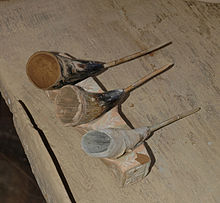Malhorn
The Malhorn is usually a device for ceramic decoration ( slip painting ). Synonyms are Malbüchse and Gießbüchse . In the specialist literature, the diminutive form Malhörnchen is also used. Due to the decorating technique, the ceramics decorated in this way are called Malhornware . The French term for Malhorn is Barolet , the English slip trailer or slip cup , the Dutch ringeloor . However, the use of painters' horns has also been proven when painting furniture from the 17th and 18th centuries.
The term Malhorn owes its origin to the raw material (cow horn) still used in the manufacture in some pottery regions and the function (painting of leather-hard, dried or cooked ceramics with paintwork or colored clay slurry ). The horn serves as a container for the painting robe. A goose quill inserted into the tip allows the painting obstruction to flow out.
In the German-speaking countries, ceramic squirrels were increasingly used in addition to cow horns from the 16th century. With all their individual design, these usually have a filling opening on the top. The opening for inserting the goose quill, also used here, is in the tip of the squirrel. The sides can be dented a bit so that the device can be held more easily while painting or writing. The oldest painting croissants still preserved today come from the Werra-Ware pottery in Enkhuizen NL (1602 to 1613, private property) and from the pottery of Caspar Muller in Hannoversch-Münden D. The latter dates to the time before 1612. As decorated with the Malhorn However, earthenware was found everywhere in German-speaking countries (NL, D, A, CH) from around 1550 onwards, and older specimens should also be found in archaeological excavations in the long term. A special feature are two-chamber, ceramic painting squirrels, with the help of which two differently colored painting gobes could be applied at the same time. This is u. a. one of the peculiarities of the so-called Weser goods , which were produced in the second half of the 16th and early 17th centuries in the region of southern Lower Saxony / northern Hesse.
In the ceramics industry in England, multi-chamber grinding bushes and three-chambered slip cups were developed soon after 1800 , with which the patterns cat's eye or cable or earthworm were then produced. You can also use it to apply several decorative colors at the same time for marbling effects.
Today, instead of the ceramic squirrels, pear-shaped devices made of rubber are used, which allow better control of the outflow of paint.
literature
- Alice Kaltenberger: Ceramics of the Middle Ages and Modern Times in Upper Austria (Nearchos 17 = Studies on the Cultural History of Upper Austria, Volume 23), Innsbruck 2009, especially 188 and Fig. 181–197.
- Adri van der Meulen / Paul Smeele: Frieze Aardewerk. De pottenbakkers van Friesland 1750–1950 (Fries Aardewerk VII), Leiden 2005, Figs. 21.2 and 21.3.
- Wingolf Lehnemann: From clay to pot in: Wilhelm Elling, Ochtruper Irdenware , Ochtrup 1998, 55–78, especially cat. No. 24–26.
Individual evidence
- ↑ Ulrich Schießl : Malhorn, model and cartridge. Technological investigations on paintings on old Bavarian furniture from the 17th and 18th centuries from the holdings of the Bavarian National Museum . Maltechnik, Restauro 87, 1981, 155-183.
- ↑ Hans-Georg Stephan: Ceramics of the Renaissance in the Upper Weser area and on the lower Werra (Journal for Archeology of the Middle Ages, Supplement 7), Cologne 1992, Fig. 45.
- ^ Christian Leiber, From the Pottland into the world. A historical pottery region between the Weser and Leine, Holzminden 2012, 215 cat. 52.
- ↑ http://www.chipstone.org/article.php/9/Ceramics-in-America-2001/Slip-Decoration-in-the-Age-of-Industrialization
Web links
- Film on the production of Malhornware in the Alt-Langnau style , accessed on December 12, 2015
- Lüneburg city archeology: Malhornware , accessed on January 24, 2011
- Pottery in the Perg area , accessed on March 26, 2013
- Film about the production of Malhornware in Horezu, Romania

